
The Englischer Garten is a large public park in the centre of Munich, Bavaria, stretching from the city centre to the northeastern city limits. It was created in 1789 by Sir Benjamin Thompson (1753–1814), later Count Rumford, for Prince Charles Theodore, Elector of Bavaria. Thompson's successors, Reinhard von Werneck (1757–1842) and Friedrich Ludwig von Sckell (1750–1823), advisers on the project from its beginning, both extended and improved the park.

Linderhof Palace is a Schloss in Germany, in southwest Bavaria near the village of Ettal. It is the smallest of the three palaces built by King Ludwig II of Bavaria and the only one which he lived to see completed.
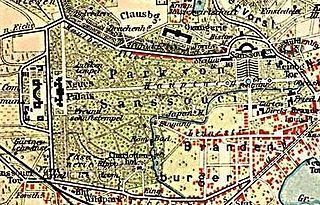
Sanssouci Park is a large park surrounding Sanssouci Palace in Potsdam, Germany, built under Frederick the Great in the mid-1700s. Following the terracing of the vineyard and the completion of the palace, the surroundings were included in the structure. A Baroque flower garden with lawns, flower beds, hedges and trees was created. In the hedge quarter 3,000 fruit trees were planted. The greenhouses of the numerous nurseries contained oranges, melons, peaches and bananas. The goddesses Flora and Pomona, who decorate the entrance obelisk at the eastern park exit, were placed there to highlight the connection of a flower, fruit and vegetable garden. Along with the Sanssouci Palace and other neaby palaces and parks, Sanssouci Park was inscribed on the UNESCO World Heritage List in 1990 for its unique architectural unity and testimony to 18th and 19th century landscaping in Europe.
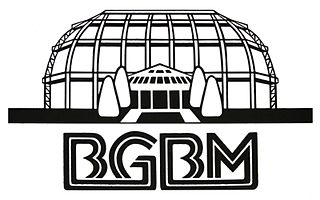
The Berlin Botanic Garden and Botanical Museum is a botanical garden in the Lichterfelde locality of the borough of Steglitz-Zehlendorf, Berlin, Germany. Constructed between 1897 and 1910 under the guidance of architect Adolf Engler, it has an area of 43 hectares [ha] and around 22,000 different plant species. The garden is part of the Free University of Berlin.

The Glaspalast was a glass and iron exhibition building located in the Old botanical garden in Munich modeled after the Crystal Palace in London. The Glaspalast opened for the first General German Industrial Exhibition on July 15, 1854.

The Old Botanical Garden is a botanical garden and arboretum in the Swiss city of Zürich. The garden is, among the neighbored Schanzengraben moat and the Bauschänzli bastion, one of the last remains of the Baroque fortifications of Zürich, that was begun in 1642.

The Botanischer Garten der Christian-Albrechts-Universität zu Kiel, or less formally the Botanischer Garten Kiel, is a botanical garden and arboretum maintained by the University of Kiel. It is located at Am Botanischen Garten 1, Kiel, Schleswig-Holstein, Germany, and open daily.
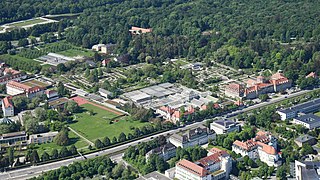
The Botanischer Garten München-Nymphenburg is a botanical garden and arboretum in Munich, Germany.
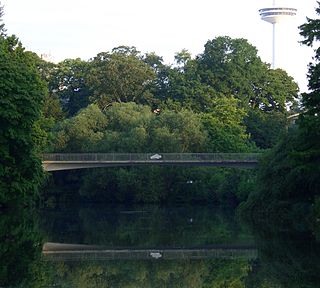
The Alter Botanischer Garten Hamburg, sometimes also known as the Schaugewächshaus or the Tropengewächshäuser, is a botanical garden now consisting primarily of greenhouses in the Planten un Blomen park of Hamburg, Germany. Alter Botanischer Garten is located on the Hamburg Wallring at Stephansplatz and is open daily without charge.

The Alter Botanischer Garten Marburg, also known as the Alter Botanischer Garten am Pilgrimstein, is a historic arboretum and botanical garden maintained by the University of Marburg and located at Pilgrimstein 3, Marburg, Hesse, Germany. It is open daily without charge.

The Flora und Botanischer Garten Köln is a municipal formal park and botanical garden located adjacent to Cologne Zoological Garden at Amsterdamer Straße 34, Cologne, North Rhine-Westphalia, Germany. It is open daily without charge.

Pillnitz Palace is a restored Baroque schloss at the eastern end of the city of Dresden in the German state of Saxony. It is located on the bank of the River Elbe in the former village of Pillnitz. It was the summer residence of many electors and kings of Saxony; it is also known for the Declaration of Pillnitz in 1791.

Maxvorstadt is a central borough of Munich, Bavaria, Germany and forms the Stadtbezirk (borough) 3 Maxvorstadt. Since 1992, this borough comprises the former boroughs 5, 6 and 7.

Sep Ruf was a German architect and designer strongly associated with the Bauhaus group. He was one of the representatives of modern architecture in Germany after World War II. His elegant buildings received high credits in Germany and Europe and his German pavilion of the Expo 58 in Brussels, built together with Egon Eiermann, achieved worldwide recognition. He attended the Interbau 1957 in Berlin-Hansaviertel and was one of the three architects who had the top secret order to create the governmental buildings in the new capital city of the Federal Republic of Germany, Bonn. His best known building was the residence for the Federal Chancellor of the Federal Republic of Germany, built for Ludwig Erhard, the so-called Chancellor's Bungalow.
Wilhelm Schacht was a German botanist, gardener, photographer and author. He became known for being senior staff member of Botanischer Garten München-Nymphenburg, whose open air department he took care of for 21 years.
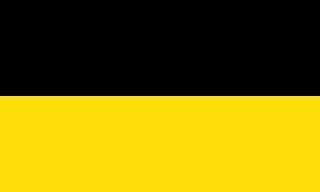
The following outline is provided as an overview of and topical guide to Munich:

The Königinstraße is a street in Munich. It runs west of the Englischer Garten from the Von-der-Tann-Straße in the district of Maxvorstadt, to the north and to the Maria-Josepha-Straße and Mandlstraße in the Ensemble Alt-Schwabing.

The Türkenstraße is an inner city street in Munich's district Maxvorstadt. It is named after the Türkengraben to which it ran. In the list of historical monuments in Munich, more than 30 objects are listed in the Türkenstraße.

The Nymphenburg Palace Park ranks among the finest and most important examples of garden design in Germany. In combination with the palace buildings, the Grand circle entrance structures and the expansive park landscape form the ensemble of the Nymphenburg Summer Residence of Bavarian dukes and kings, located in the modern Munich Neuhausen-Nymphenburg borough. The site is a Listed Monument, a Protected Landscape and to a great extent a Natura2000 area.
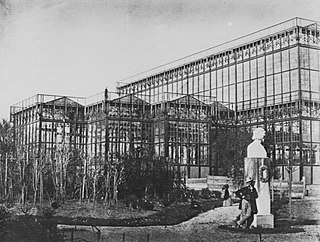
The General German Industrial Exhibition was designed to demonstrate German industry to a global audience, but was adversely impacted by a cholera epidemic.
























